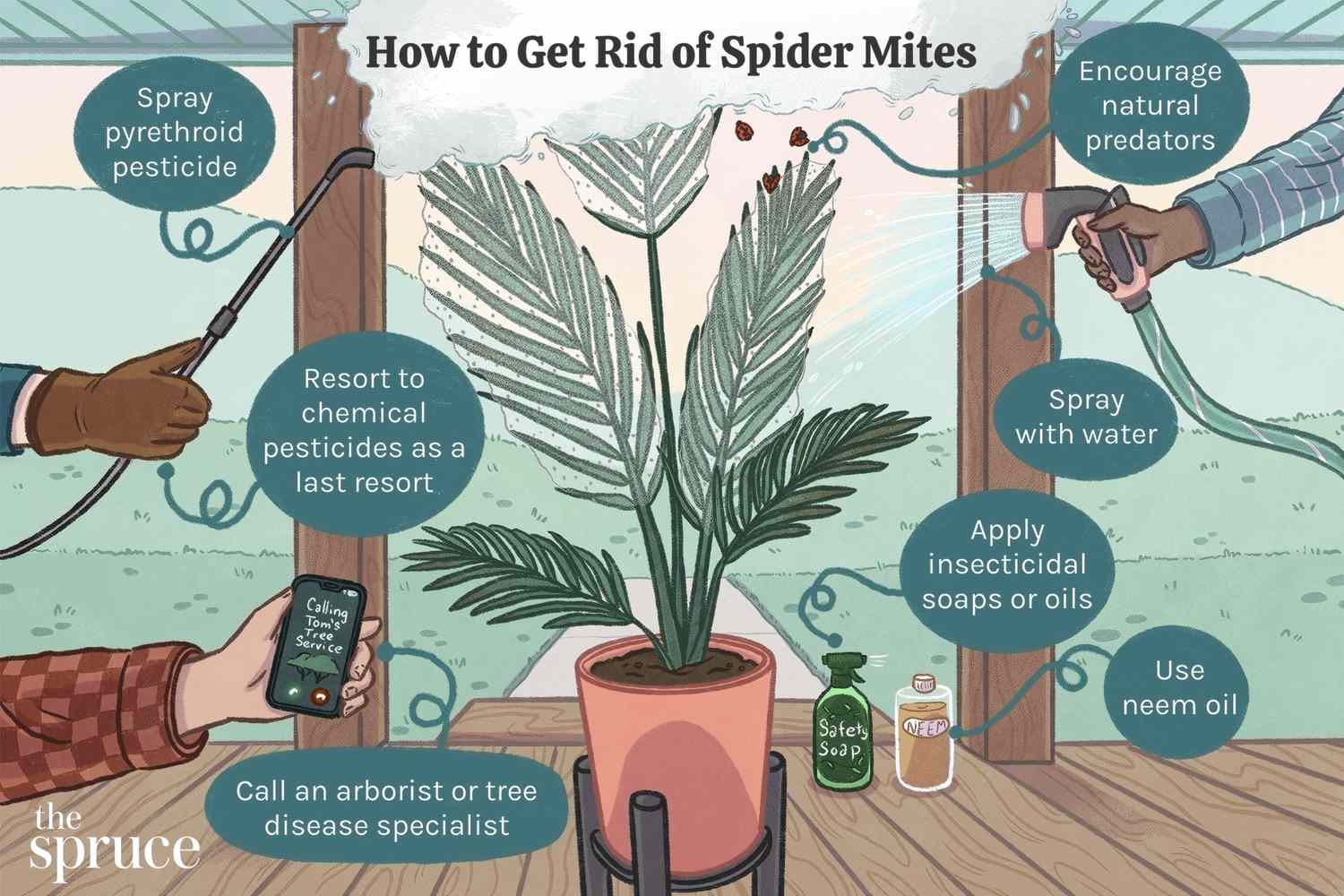The easiest way to get rid of spider mites is to spray affected plants with a mixture of water and dish soap. Spider mites can be a nuisance for gardeners and indoor plant enthusiasts.
These tiny pests can quickly multiply and damage the leaves of plants, causing them to wilt and die. Fortunately, there are several effective methods for controlling spider mite infestations. We’ll explore some simple and natural ways to eliminate these troublesome pests and prevent future infestations.
By following these tips, you can keep your plants healthy and free from spider mites.
Introduction To Spider Mites
Spider mites are tiny pests that can wreak havoc on your plants, causing damage to their leaves and overall health. These minuscule arachnids are a common nuisance for gardeners and indoor plant enthusiasts alike. In this section, we will explore the signs of infestation and why spider mites are a problem, as well as the easiest way to get rid of them.
Signs Of Infestation
If you notice tiny, speck-like creatures moving around on the underside of your plant leaves, along with small webs and stippling on the foliage, these are telltale signs of a spider mite infestation. Additionally, your plants may start to exhibit yellow or brown spots, wilt, or drop leaves due to the damage caused by these pests.
Why They’re A Problem
Spider mites are a problem because they feed on the sap of plants, leading to reduced photosynthesis and overall plant vigor. Their rapid reproduction and ability to develop resistance to pesticides make them a persistent challenge to eradicate. Moreover, their small size and quick mobility make them difficult to detect and eliminate, allowing infestations to escalate rapidly.

Credit: www.gardenersworld.com
Identifying Spider Mites
Identifying spider mites can be tricky as they are tiny and often go unnoticed until their damage is visible. The easiest way to get rid of spider mites is by using a natural predator, such as ladybugs, or applying a solution of water and dish soap to the affected plants.
Regularly inspecting and treating plants can prevent spider mite infestations.
Physical Characteristics
Spider mites are tiny pests, barely visible to the naked eye. They have eight legs and range in color from red to green. Their bodies are oval-shaped and they have two dark spots on their backs.Common Habitats
Spider mites are commonly found in warm, dry environments such as greenhouses or indoor plants. They thrive in dusty conditions and are known to infest a wide range of plants, including vegetables and flowers.Immediate Actions To Take
Combat spider mites by immediately spraying plants with a mixture of water and dish soap. Alternatively, introduce natural predators like ladybugs to eliminate the infestation. Regularly inspect plants for signs of infestation and take action promptly to prevent the spread of spider mites.
Spider mites can be a menace to your plants if left unchecked. These tiny pests can quickly multiply and cause severe damage, leading to stunted growth, yellowing leaves, and eventually plant death. Taking immediate action to get rid of spider mites is crucial to save your plants. Here are some steps you can take:Isolating Infected Plants
The first step to control spider mites is to isolate the infected plants. This will prevent the pests from spreading to other plants. You can use a plastic bag or a box to cover the plant. Ensure that the covering does not touch the plant, as this can damage the leaves. Alternatively, you can move the plant to a separate room or area away from other plants.Reducing Humidity
Spider mites thrive in warm and humid conditions. Reducing humidity can help to slow down their growth. You can use a dehumidifier or an air conditioner to lower the humidity levels in the room. Additionally, you can place a small fan near the plants to improve air circulation, which will help to dry out the leaves and make it harder for the spider mites to survive.Using Insecticidal Soap
Insecticidal soap is a safe and effective way to get rid of spider mites. You can buy it from your local garden center or make your own at home. Mix one tablespoon of mild liquid soap with one quart of water and pour it into a spray bottle. Spray the solution on the affected plants, making sure to cover the undersides of the leaves. Repeat the process every three days until the spider mites are gone.Vacuuming
Vacuuming the affected plants is another effective way to get rid of spider mites. Use a handheld vacuum cleaner with a soft brush attachment to gently remove the pests from the leaves. Be sure to dispose of the vacuum bag or empty the canister immediately after use to prevent the spider mites from escaping.Taking immediate action is the key to getting rid of spider mites. Isolating infected plants, reducing humidity, using insecticidal soap, and vacuuming are all effective methods to control spider mites. By following these steps, you can protect your plants and keep them healthy and thriving.Natural Remedies
When it comes to getting rid of spider mites, natural remedies can be an effective and eco-friendly option. These remedies are safe to use around children and pets, and they can help control the infestation without the use of harmful chemicals. Here are three natural remedies that can help you tackle spider mites:
Neem Oil Treatment
Neem oil is a popular natural remedy for spider mites. This oil is derived from the neem tree and has insecticidal properties that can kill mites on contact. To use neem oil, dilute it with water according to the instructions on the bottle and apply it to the affected plants using a spray bottle or a garden sprayer. Make sure to cover both the upper and lower surfaces of the leaves, as spider mites tend to congregate on the undersides of leaves.
Diatomaceous Earth
Diatomaceous earth is another effective natural remedy for spider mites. This powdery substance is made from the fossilized remains of diatoms, which are tiny aquatic organisms. Diatomaceous earth works by dehydrating the mites and damaging their outer shells, ultimately leading to their demise. To use diatomaceous earth, simply sprinkle it on the leaves of the affected plants, making sure to cover both the tops and bottoms of the leaves. Repeat this process every few days until the mite infestation is under control.
Homemade Sprays
In addition to neem oil and diatomaceous earth, you can also create homemade sprays to combat spider mites. One popular homemade spray is a mixture of water, dish soap, and garlic. To make this spray, combine a few drops of dish soap, a crushed garlic clove, and water in a spray bottle. Shake well and then spray the mixture onto the affected plants. The soap helps suffocate the mites, while the garlic acts as a natural repellent. Remember to reapply the spray every few days until the infestation is eliminated.
Chemical Solutions
When dealing with spider mites, chemical solutions can be an effective method to quickly eliminate these pests.
Selecting The Right Pesticide
Choose a pesticide specifically formulated to combat spider mites, such as those containing pyrethroids or neem oil.
Application Tips
- Thoroughly read and follow the instructions on the pesticide label.
- Apply the pesticide directly to the affected plants, targeting the underside of leaves where spider mites often reside.
- Reapply the pesticide as directed to ensure complete eradication of the spider mites.
Preventive Measures
Preventive measures are crucial in keeping spider mites at bay and maintaining the health of your plants. By implementing the following strategies, you can effectively prevent infestations and ensure the well-being of your greenery.
Regular Monitoring
Regularly inspect your plants for any signs of spider mite infestation. Look for yellow stippling on leaves, fine webbing, and stunted growth. Catching the infestation early can prevent it from spreading and causing extensive damage.
Maintaining Plant Health
Healthy plants are more resilient to pest infestations, including spider mites. Ensure your plants are well-watered and receive adequate sunlight. Consider pruning to remove any heavily infested areas and promote overall plant vigor.
When To Call A Professional
For the easiest way to get rid of spider mites, call a professional when the infestation persists despite DIY efforts. Professional intervention ensures thorough eradication and prevents future outbreaks effectively.
When to Call a Professional:Assessing the Infestation:Before deciding whether to call a professional or not, it’s important to assess the severity of the spider mite infestation. If you only have a few mites, it’s possible to control the problem on your own. However, if there are a large number of spider mites, it’s best to seek professional help.Benefits of Professional Help:Professional spider mite exterminators have the knowledge and tools necessary to effectively and safely eliminate spider mites. They can also identify the type of spider mite infestation you have and provide a targeted treatment plan. Additionally, a professional exterminator can provide ongoing maintenance to prevent future infestations.If you’re unsure whether to call a professional or not, consider the severity of the infestation and the potential risks associated with DIY treatment. In most cases, it’s best to seek professional help to ensure the spider mites are completely eliminated and to prevent future infestations.
Credit: www.youtube.com

Credit: www.youtube.com
Frequently Asked Questions
How Do Spider Mites Affect Plants?
Spider mites are tiny pests that feed on the sap of plants, causing yellowing leaves, webbing, and stunted growth. They can quickly multiply and infest your plants, leading to severe damage if left untreated.
What Are The Signs Of A Spider Mite Infestation?
Look out for small, speck-like pests on the undersides of leaves, yellow or discolored leaves, fine webbing, and tiny brown spots on the foliage. If you notice these signs, it’s likely that your plants are infested with spider mites.
What Is The Easiest Way To Get Rid Of Spider Mites?
One effective method to eliminate spider mites is to spray your plants with a mixture of water and insecticidal soap. Ensure you cover both sides of the leaves. Repeat the process every few days until the infestation is gone. Regularly inspect and isolate affected plants to prevent further spread.
How Can I Prevent Spider Mite Infestations?
To prevent spider mite infestations, maintain a clean and healthy garden by regularly pruning and removing any infested plant parts. Increase air circulation around plants, avoid over-fertilizing, and regularly inspect plants for any signs of pests. Introducing beneficial insects, like ladybugs, can also help control spider mites naturally.
Conclusion
Incorporating natural remedies effectively eliminates spider mites. Regular monitoring and swift action are crucial. Prioritize preventive measures to safeguard your plants. Remember, a healthy environment is key to keeping spider mites at bay. With diligence and patience, you can successfully combat these pests.
Related posts:

I’m MD Tanvir, and I bring years of expertise gained from working closely with pest control companies to the forefront. My journey in the industry has inspired me to launch Bug Battler, a platform aimed at equipping people with the know-how to combat pests autonomously. Through Bug Battler, I aim to empower individuals with practical insights to tackle pest infestations effectively.

